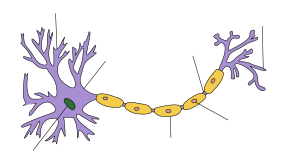
- Image via Wikipedia
Scientists in the Hotchkiss Brain Institute at the Faculty of Medicine, University of Calgary, have discovered a new mechanism that nerve cells (neurons) use to fine-tune their electrical output. The discovery, published in the journal Nature Neuroscience, provides new insights about how the activity of the nervous system is regulated at the cellular level.
Nerve cells in our nervous system use electrical impulses to transmit signals throughout our body. One way that they do this is through the trafficking of calcium channels through to the outer surface (plasma membrane) of the cell. Calcium entry into a neuron through a calcium channel is a critical first step in allowing communication between neurons.
HBI researchers Gerald Zamponi Ph.D., Christophe Altier Ph.D. and Agustin Garcia-Caballero Ph.D. study how calcium channels, and the proteins that associate with them, help control nerve cell activity. They explored how one such protein, the beta subunit, can act as a regulatory mechanism for the ‘L-type’ calcium channel. These channels play an important role in the proper functioning of nerve, muscle, and cardiac pacemaker cells, but when the channels are overactive this has negative consequences that can give rise to conditions such as autism and hypertension.
The new finding adds significantly to our understanding of calcium channel function in health and disease, including several debilitating conditions. “The abnormal regulation of ‘L-type’ calcium channels has been linked to conditions such as epilepsy, cardiac arrhythmia and chronic pain” says Altier, “and so understanding the role of regulatory influences such as the beta subunit will be an important part of treating these diseases.”
Related articles
- How to Grow New Neurons in Your Brain. (psychologytoday.com)
- New discovery may lead to advances in treating anxiety disorders (news.bioscholar.com)

